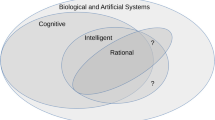Abstract
On a literal reading of `Computing Machinery and Intelligence', Alan Turing presented not one, but two, practical tests to replace the question `Can machines think?' He presented them as equivalent. I show here that the first test described in that much-discussed paper is in fact not equivalent to the second one, which has since become known as `the Turing Test'. The two tests can yield different results; it is the first, neglected test that provides the more appropriate indication of intelligence. This is because the features of intelligence upon which it relies are resourcefulness and a critical attitude to one's habitual responses; thus the test's applicablity is not restricted to any particular species, nor does it presume any particular capacities. This is more appropriate because the question under consideration is what would count as machine intelligence. The first test realizes a possibility that philosophers have overlooked: a test that uses a human's linguistic performance in setting an empirical test of intelligence, but does not make behavioral similarity to that performance the criterion of intelligence. Consequently, the first test is immune to many of the philosophical criticisms on the basis of which the (so-called) `Turing Test' has been dismissed.
Similar content being viewed by others
References
Churchland, P.A. (1996), 'Learning and Conceptual Change: The View from the Neurons', in A. Clark and P.J.R. Millican, eds., Connectionism, Concepts and Folk Psychology: The Legacy of Alan Turing, Vol. 2, Oxford: Clarendon Press.
Dennett, D.C. (1998), 'Can Machines Think?' in Brainchildren, Cambridge, MA: MIT Press.
Descartes, R. (1987), Discourse on Method, Cottingham, J. (Trans.). Cambridge: Cambridge University Press.
Dick, P.K. (1982), Do Androids Dream of Electric Sheep?, New York: Ballantine Books.
Dreyfus, H.L. (1979) What Computers Can't Do, Revised Edition. New York: Harper Colophon Books.
French, R.M. (1990). 'Subcognition and the Limits of the Turing Test', Mind 99.
Genova, J. (1994), 'Turing's Sexual Guessing Game', Social Epistemology 8(4), pp. 313-326.
Gunderson, K. (1964), 'Descartes, LaMettrie, Language, and Machines', Philosophy 39, pp. 193-222.
Haugeland, J. (1985), Artificial Intelligence: The Very Idea, Cambridge: MIT Press.
Hayes, P. and Ford, K. (1995), 'Turing Test Considered Harmful', Proceedings of the Fourteenth International Joint Conference on Artificial Intelligence (IJCA195-1). Montreal, Quebec, Canada. pp. 972-997.
Heil, J. (1998), Philosophy of Mind: A Contemporary Introduction. London and New York: Routledge.
Hodges, A. (1983), Alan Turing: The Enigma, New York: Simon and Schuster.
Hofstadter, D.R. (1981), 'A Coffeehouse Conversation', Scientific Americans, May 1981, pp. 15-36.
Hofstadter, D.R. (1985), Metamagical Themas, New York: Basic Books.
Hofstadter, D.R. (1996), 'Analogy-Making, Fluid Concepts, and Brain Mechanisms', Connectionism, Concepts, and Folk Psychology: The Legacy of Alan Turing. Vol. II, Oxford: Clarendon Press, pp. 195-247.
Leiber, J. (1991), An Invitation to Cognitive Science, Cambridge, MA: Basil Blackwell.
Massey, G.J. and Boyle, D.A. (1999), 'Descartes's Tests for (Animal) Mind' (forthcoming, Philosophical Topics 27, Special Issue on Zoological Philosophy and Philosophical Ethology).
Michie, D. (1993), 'Turing's Test and Conscious Thought', Artificial Intelligence 60, pp. 1-22.
Moor, J.H. (1992), 'Turing Test', Encyclopedia of Artificial Intelligence, 2nd Edition, New York: John Wiley & Sons, pp. 1625-1627.
Moor, J.H. (1976), 'An Analysis of the Turing Test', Philosophical Studies 30, pp. 249-257.
Piccinini, G. (2000), 'Turing's Rules for the Imitation Game', Minds and Machines 10, pp. 573-582.
Ryle, G. (1949), The Concent of Mind, Chicago: University of Chicago Press.
Schank, R. (1984), The Cognitive Computer, Reading, MA: Addison-Wesley.
Shieber, S.M. (1994), 'Lessons From a Restricted Turing Test', Communications of the ACM; 37(6).
Traiger, S. (2000), 'Making the Right Identification', Minds and Machines (this volume).
Turing, A.M. (1950), 'Computing Machinery and Intelligence', Mind, 59, pp. 433-460.
Turing, A.M. (1996), 'Intelligent Machinery, A Heretical Theory', Philosophia Mathematica, (3) 4, pp. 256-260.
Wallace, R. (1997), 'The Lying Game', Wired, Vol. 5, No. 8, August 1997.
Whitby, B. (1996), 'The Turing Test: Al's Biggest Blind Alley?' in P.J.R. Milllican and A. Clark, eds., Machines and Thought: The Legacy of Alan Turing. Vol. 1, Oxford: Clarendon Press.
Rights and permissions
About this article
Cite this article
Sterrett, S.G. Turing's Two Tests for Intelligence*. Minds and Machines 10, 541–559 (2000). https://doi.org/10.1023/A:1011242120015
Issue Date:
DOI: https://doi.org/10.1023/A:1011242120015



